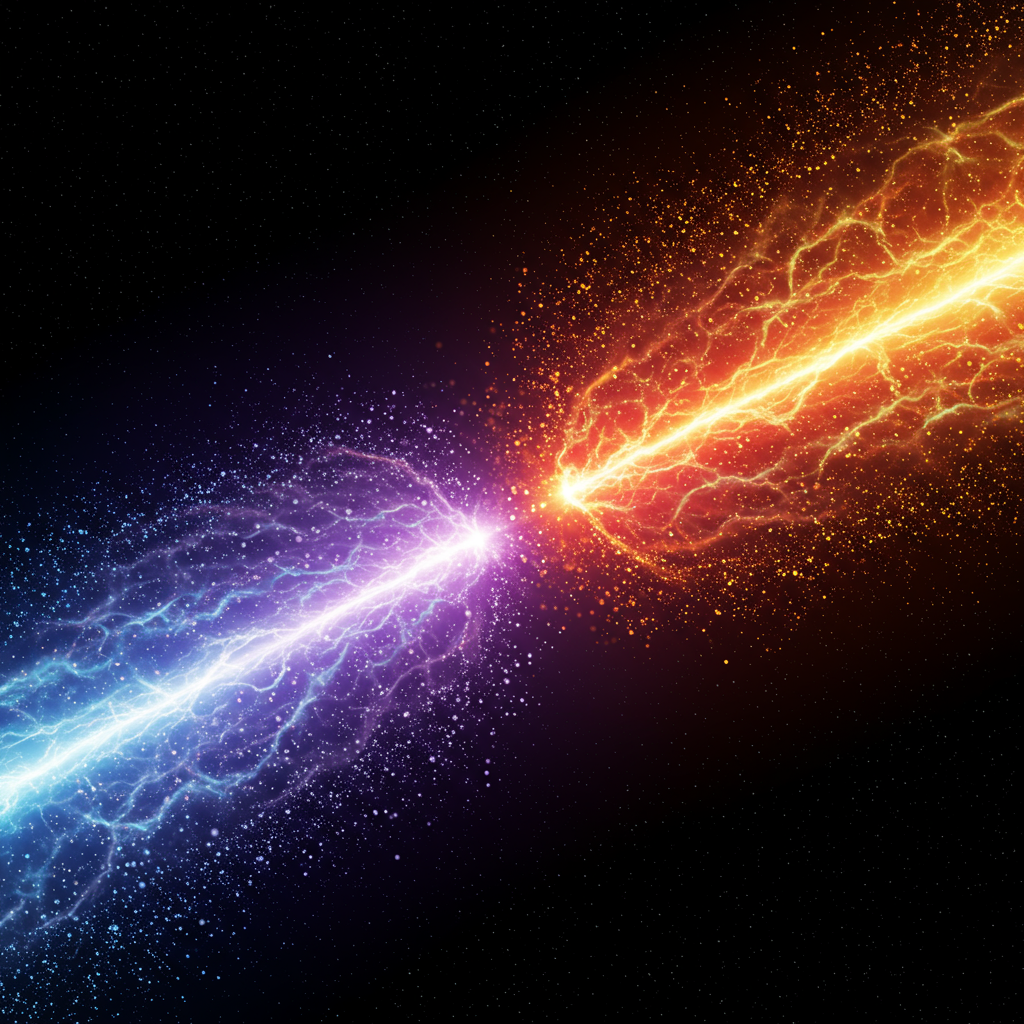From the smallest atom to the grandest galaxy, matter defines our reality. Yet, its very existence is one of the universe’s most profound and perplexing enigmas. Conventional physics predicts that the Big Bang, the universe’s fiery birth, should have forged equal amounts of matter and its elusive counterpart, antimatter. These two particle types are destined to annihilate each other upon contact, leaving behind nothing but pure energy. So, why do we find ourselves on a planet orbiting a star, surrounded by billions of galaxies, all composed almost entirely of matter? This cosmic imbalance, a tiny but crucial asymmetry, is the subject of intense investigation by physicists worldwide, with recent breakthroughs offering exciting new clues.
The Universe’s Fundamental Imbalance: A Cosmic Paradox
Imagine a universe born with a perfect balance: for every particle of matter, an identical twin of antimatter. In such a scenario, the early universe would have been a fleeting dance of creation and immediate annihilation, quickly settling into an existence of only light. However, observations paint a dramatically different picture. Our observable universe is a vast expanse brimming with matter—stars, planets, dust, and gas—with antimatter being incredibly rare, primarily created only in high-energy collisions or certain radioactive decays. This stark discrepancy, famously known as the baryon asymmetry problem, hints at a subtle but fundamental bias in the universe’s early moments, ensuring matter’s triumph over antimatter. Unraveling why matter exists is key to understanding our cosmic origins.
Neutrinos: Ghost Particles Offering New Answers
Recent experimental findings provide compelling evidence that one of the universe’s most elusive particles, the neutrino, might hold a significant piece of this puzzle. Neutrinos are subatomic particles with no electrical charge and incredibly tiny masses, millions of times lighter than an electron. They are often dubbed “ghost particles” because they rarely interact with other matter, streaming through us and even the Earth itself, virtually undetected.
A groundbreaking collaborative study, spearheaded by Fermilab in the United States and involving hundreds of international researchers, including physicists from Tufts University, has focused on the peculiar behavior of these particles. Their work, published in Nature, suggests that subtle differences in how neutrinos and antineutrinos behave could have tipped the cosmic scales.
Unveiling Neutrino Oscillations and Their Asymmetry
The NOvA scientific collaboration at Fermilab, alongside the T2K project in Japan, has been meticulously studying neutrino oscillations. Neutrinos are produced in three “flavors”—electron, muon, and tau neutrinos. Intriguingly, each flavor is not a static entity but a quantum “superposition” or mix of three different mass states. Think of a neutrino like a musical chord played on three strings, each vibrating at a slightly different frequency due to their varying masses. As this neutrino “chord” travels through space, the frequencies shift relative to each other, creating a quantum “beat pattern.” This pattern manifests as the neutrino changing its flavor, or “oscillating,” from one type to another.
The core hypothesis is that if neutrinos and antineutrinos oscillate differently—meaning their mass states interact or shift distinctly—this asymmetry could explain why matter exists. Such a difference, even a tiny one, in the early universe could have led to a crucial excess of matter over antimatter, potentially by just one part per billion.
The Decade-Long Quest at Fermilab and T2K
For over a decade, the NOvA and T2K experiments have been designed to precisely measure these oscillations. Researchers generate beams of neutrinos and antineutrinos of a specific flavor (muon neutrinos) using particle accelerators. These particles are then directed through hundreds of miles of Earth to massive detectors.
At Fermilab, for instance, neutrinos produced near Chicago travel 503 miles to a colossal 14,000-ton “far detector” in Ash River, Minnesota. A smaller “near detector” provides a baseline measurement close to the source. By comparing the neutrino flavors detected at both locations, physicists can quantify the extent of oscillation. Tufts University physicists Hugh Gallagher, W. Anthony Mann, and Jeremy Wolcott made vital contributions, particularly in understanding how neutrinos interact with these detectors. Wolcott also coordinated the complex analysis across both NOvA and T2K datasets.
The challenges are immense. As Wolcott explains, the detectors are bombarded by natural background particles 150,000 times per second, yet they register only about one accelerator-generated neutrino per day. Despite these difficulties, the NOvA experiment did observe differences in oscillation patterns between neutrinos and antineutrinos. While this finding is a significant step, a definitive conclusion on the matter-antimatter imbalance requires collecting substantially more data to account for complex variables, such as the unknown ordering of neutrino mass states.
CERN’s LHCb: CP Violation in Baryons Offers Another Angle
While neutrinos provide one set of clues, another crucial insight into why matter exists comes from CERN’s Large Hadron Collider (LHC). The LHCb experiment, analyzing particle collisions, has discovered a significant new instance of Charge-Parity (CP) violation. CP violation refers to a subtle breaking of symmetry where matter and antimatter do not behave in perfectly mirrored ways.
Previous observations of CP violation primarily involved “mesons,” a different class of particles. However, the LHCb team observed CP violation in the lambda-beauty baryon (Λb) and its antimatter equivalent. Baryons, such as protons and neutrons, are the fundamental constituents of most ordinary matter. Observing this asymmetry in baryons is particularly impactful because it directly relates to the building blocks of the visible universe.
A Measured Asymmetry: More Than a Coincidence
Scientists at CERN meticulously analyzed over 80,000 particle decay events, revealing that Λb baryons and their antimatter counterparts decay at measurably different rates—specifically, by approximately 2.5 percent. This difference carries a statistical significance of 5.2 sigma, a gold standard in particle physics indicating a “discovery” with an extremely low probability of being a random fluctuation.
Lead author Xueting Yang notes that this observation confirms these subtle differences exist in a wider range of particles. However, it’s important to clarify that while groundbreaking, the observed CP violation in Λb baryons, consistent with the Standard Model, is not substantial enough on its own to explain the entire cosmic matter excess. This suggests that while the Standard Model accurately predicts some asymmetry, it remains incomplete in fully accounting for why matter exists in such overwhelming abundance. It points physicists toward “new physics” beyond the current Standard Model, hinting at undiscovered phenomena that contributed to matter’s survival.
Beyond the Standard Model: Exploring Cosmic Knots and Elusive Particles
The quest to understand why matter exists also pushes the boundaries of theoretical physics, exploring concepts far beyond current experimental reach, yet offering intriguing solutions.
The Resurgence of Cosmic Knots
One fascinating theoretical approach re-examines a forgotten 19th-century “vortex” model of the atom by Lord Kelvin. While Kelvin’s original concept was disproven, the underlying idea of topological knots—stable structures that persist unless fundamentally broken—has found new life in modern particle physics. A team of physicists now proposes that “cosmic knots” could have formed in the very early universe, potentially dominating it for a period.
According to this theory, these stable knot solitons could have emerged from the spontaneous breaking of symmetries in the nascent universe. These metastable knots, formed from linked “cosmic strings,” would then untangle through quantum tunneling, producing heavy right-handed neutrinos. These “special” neutrinos, as Yu Hamada explains, could then decay in a way that naturally generates the matter-antimatter imbalance, effectively acting as the “parents” of all matter. This model, published in Physical Review Letters, could also address other cosmic mysteries like dark matter and neutrino masses, though it requires further development and future observational evidence from gravitational-wave experiments like LISA.
The Search for String Theory’s “Forbidden” 5-Plet
Another audacious theoretical avenue involves challenging string theory itself. A team including physicists from the University of Pennsylvania and Arizona State University is actively searching for a hypothetical five-particle structure, or “5-plet,” that string theory models currently predict should not exist. If detected at the LHC, this “supersized cousin” of more common particle families, conceptualized as a Majorana fermion, would signify a fundamental flaw or incompleteness in string theory.
Spotting a 5-plet is incredibly difficult due to its high mass and rapid decay. If created, its charged particles would quickly decay into a low-energy pion and an invisible neutral particle (X0), creating a distinctive “vanishing track” signature in detectors like ATLAS and CMS. Beyond stress-testing string theory, the discovery of a 5-plet offers a double win: its neutral member could be the elusive dark matter that accounts for roughly 85% of the universe’s matter. This novel approach highlights that sometimes, the search for what a theory forbids can lead to the most profound discoveries about why matter exists.
The Ongoing Quest: Unveiling Our Cosmic Narrative
The question of why matter exists is not just an academic puzzle; it’s fundamental to our understanding of the universe and our place within it. From the painstaking data collection of neutrino oscillations at Fermilab and T2K, to the precise measurements of CP violation in baryons at CERN, to the speculative yet powerful theoretical frameworks exploring cosmic knots and new particles, the scientific community is employing every tool at its disposal.
These diverse research fronts, though seemingly disparate, collectively push the boundaries of knowledge. The journey to fully unravel this cosmic enigma is far from over, demanding continued collaboration, innovation, and perhaps, the discovery of entirely new physics beyond our current understanding. Each clue, however small, brings humanity closer to completing the grand narrative of how a universe born of pure energy ultimately became a vibrant tapestry of matter, life, and consciousness.
Frequently Asked Questions
What is the primary theory explaining the matter-antimatter imbalance?
The leading experimental explanation for the matter-antimatter imbalance, which addresses why matter exists, focuses on the subtle behavior of neutrinos. The Fermilab NOvA and Japan’s T2K experiments suggest that differences in how neutrinos and antineutrinos oscillate (change flavor) could have created a slight excess of matter in the early universe, possibly by one part per billion. This subtle asymmetry would have allowed matter to survive the annihilation events with antimatter after the Big Bang, leading to the matter-dominated universe we observe today.
How do experiments like Fermilab’s NOvA and CERN’s LHCb contribute to solving this mystery?
Fermilab’s NOvA and T2K experiments study neutrino oscillations by creating neutrino and antineutrino beams and detecting their flavor changes over long distances. Their goal is to find differences in oscillation patterns between matter and antimatter neutrinos, which could explain the cosmic imbalance. CERN’s LHCb experiment, on the other hand, investigates charge-parity (CP) violation in baryons (like the lambda-beauty baryon). It has found that matter and antimatter baryons decay at slightly different rates (e.g., a 2.5% difference), confirming a form of CP violation. While this baryon asymmetry isn’t enough to fully explain the cosmic imbalance on its own, both experimental approaches provide crucial evidence that matter and antimatter do not behave identically, pointing towards the mechanisms that allowed matter to prevail.
Beyond neutrinos and baryons, what other theories are physicists exploring to understand the origin of matter?
Physicists are exploring several theoretical frontiers beyond the Standard Model to fully understand why matter exists. One theory revives the idea of “cosmic knots” or “Hopfions,” stable topological structures that could have formed in the early universe from interacting cosmic strings. These knots, through quantum tunneling, might have produced heavy right-handed neutrinos whose decay could generate the matter-antimatter imbalance. Another approach involves searching for a hypothetical “5-plet” particle, a five-member structure that current string theory models predict should not exist. Discovering such a particle at the LHC could indicate fundamental flaws in string theory and might also provide clues about the nature of dark matter, as its neutral member could be a dark matter candidate. These theoretical explorations highlight the ongoing quest for “new physics” beyond our current understanding.
—
References
- <a href="https://www.futurity.org/why-does-matter-exist-3302562-2/?utmsource=rss&utmmedium=rss&utm_campaign=why-does-matter-exist-3302562-2″>www.futurity.org
- www.iflscience.com
- www.vice.com
- www.sciencealert.com
- www.sciencedaily.com




